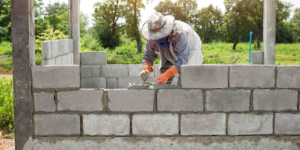A well-designed landscape not only looks beautiful but also boosts property value and provides health benefits for your family. It can reduce stress, encourage you and your family to spend more time outdoors, and help protect the environment.

Landscaping can be a great way to add beauty to an area. It can take the form of gardens, patios, flower beds and even hardscapes like pathways and retaining walls. When done correctly, it can create a cohesive look that is pleasing to the eye. Contact PristineCutsLawnCare for professional help.
The key is to focus on unity in your landscaping. This can be accomplished by using similar plant species in multiple areas or establishing a color scheme for all your landscaping elements. Using different textures in your plants can also help to create unity.
Lines are another key element to landscape design. They can be straight, curved, horizontal or diagonal. They can be created with hardscape materials such as pavers and stone or with vegetation like fences, hedges and tree limbs. They are also an excellent way to highlight a specific design feature.
A good landscaping plan will incorporate the five key aesthetic elements of line, form, texture, color and scale. The perfect balance of these features will draw the eye throughout your landscape and bring a sense of harmony to it.
There are a number of theories about why people enjoy viewing landscapes. Habitat theory suggests that aesthetically pleasurable experiences in the landscape are derived from the satisfaction of one’s basic biological needs. Prospect-refuge theory is a more recent landscape aesthetics theory that combines habitat and information processing theories. According to the theory, people are drawn to landscapes that provide a refuge from stressful or unpleasant activities and that offer an opportunity for self-fulfillment through exploration.
Increased Value
Landscaping is a great way to increase the value of your home. It’s one of the few home improvements that will continue to add value over time, as plants grow fuller and more robust with age. A well-maintained yard can also improve your home’s curb appeal, which is an important factor when it comes to selling.
In fact, real estate agents report that homes with attractive landscaping sell for up to 20% more than similar properties without landscaping. That’s because the first impression that potential buyers have of your property will be based on the landscape and not the house itself.
A professionally designed and implemented landscaping project will not only improve the aesthetics of your home, but it will increase its value as well. Whether you’re looking to make some minor changes or are planning on a major landscaping overhaul, it’s a great investment that will pay off when you’re ready to sell your home.
Another benefit of landscaping is that it can help reduce your energy costs. Well-maintained lawns with properly positioned trees, shrubs, flowers and mulch can provide shade from the sun, which helps reduce your energy usage. Likewise, planting trees can also reduce your air conditioning bills by providing natural aeration and improving the efficiency of your system.
A well-maintained landscape can also reduce your water consumption, which in turn can save you money on your utility bills. Xeriscaping, which uses low-water and drought-tolerant plants, is an excellent example of sustainable landscaping that can save you money. In addition to these benefits, proper water management can also prevent flooding and reduce pollution. Aside from reducing your water and energy bills, landscaping can also provide environmental and health benefits to you and your family.
Healthier Plants
Healthy plants are less vulnerable to insects, mites, and disease. They’re also more likely to grow well and produce flowers, fruit or seeds. The most important factor in plant health is providing the right growing conditions for your landscape plants. That includes testing the soil pH and nutrients, preparing the site correctly before planting, mulching appropriately, and weed control.
When choosing landscaping plants, trees or shrubs, look for:
Good Color – Healthy leaves are vibrant green and free of yellowing or suspicious spotting. They’re also firm and glossy, not limp or wilted.
Sturdy Stems – Healthy plants have sturdy stems that stand upright, not drooping or broken. They should be strong enough to support the plant’s weight and resist breaking under mild stress.
Proper Soil Health
Healthy soil is rich in organic matter and provides the structure for roots to grow, nutrient levels to be maintained, and water to be held in reserve. Soil with these properties is also home to microbes and other organisms that work together to help the plant thrive.
The best way to improve the quality of your soil is through composting and the addition of organic materials to reduce toxicity in the soil. The best soil has a ph level of 6.0-7.0 and is low in salts and heavy metals, but most importantly is full of organic matter. It is this type of soil that produces healthy, resilient plants and supports biodiversity. The use of native plants and grasses helps create these ecosystems, protects soil, and reduces pests and diseases.
Reduced Stress
A well-designed landscape reduces your stress level by providing a relaxing environment. A beautiful yard encourages you to spend more time outdoors and is a great place to unwind or entertain friends. It can also reduce noise pollution from nearby streets and neighbors, allowing you to enjoy the sounds of nature.
Studies have shown that spending time in natural environments can help lower your blood pressure, reduce stress and improve attention span and memory. Additionally, a healthy lawn is more resilient against environmental pollutants such as air and soil contaminants. Proper landscaping can also protect your home from environmental hazards like erosion, flooding and falling rocks by installing retaining walls and drainage systems.
Using different plants with varying textures in your garden creates visual interest and helps you to relax. You can also create a calming atmosphere by adding water features to your landscape design. These can include fountains, ponds and waterfalls. The sound of rushing water can be very soothing to the ears.
Landscaping can also provide you with a private space where you can relax and get away from the demands of everyday life. By designing a zen garden, you can create a tranquil space for meditation. You can also incorporate benches and paved seating areas to provide a space for social interaction with family and friends.
Moreover, planting native trees and shrubs is a great way to support the local ecosystem. These plants and trees prevent soil degradation, increase biodiversity and contribute to the reduction of atmospheric carbon. As a result, your backyard can become your very own mini-ecosystem.
Reduced Maintenance
Landscaping helps to reduce the amount of work required to maintain an outdoor space. A well-designed yard may require less water, fertilizer, and lawn care equipment than a traditional grassy garden. Additionally, the use of landscaping elements that suppress weed growth can reduce time spent weeding and the need for chemical herbicides.
Landscapers are able to provide customer service and help homeowners select plants, trees, shrubs, flowers, and turfgrass that can thrive in the climate of their specific region. They can also assist in the design and installation of hardscape features like walkways, patios, decks, retaining walls, fences, and water features.
Low-maintenance landscaping is a great option for people who want to spend more time relaxing in their outdoor spaces rather than working on them. Landscaping techniques like meadowscaping, which is a gardening technique that returns manicured lawns to their more natural state with high grasses and pops of color, require only periodic mowing. Other low-maintenance landscaping options include reducing the size of your lawn, incorporating mulch, and using ground cover and native grasses to reduce the need for mowing.
A well-designed yard will not only reduce the work involved to maintain it but can also benefit the environment by reducing air pollution, preserving natural resources, and enhancing the overall quality of life. Landscaping with native plants, for example, helps to decrease air pollution by absorbing and storing carbon dioxide, which is an air pollutant, in their roots, stems, and leaves.
In addition, planting trees and incorporating other green elements in the yard provides shade and reduces energy costs by lowering indoor temperatures. It also encourages people to spend more time outdoors, which is beneficial for physical health and mental wellbeing.

